
We kindly inform you that, as long as the subject affiliation of our 300.000+ articles is in progress, you might get unsufficient or no results on your third level or second level search. In this case, please broaden your search criteria.

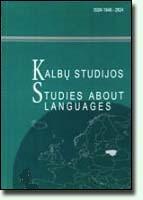
The article attempts to outline some characteristics of the selected Ukrainian-Russian-Polish-English anthropocentric phraseological units. The author strives to show a significant role of anthropocentric phraseological units in the representation of a cultural mentality, as well as in reflecting the national and cultural identity. The investigated examples are grouped into several paradigms, each reflecting a special human trait. It is the first attempt to draw parallels as well contrasts between phraseologisms in a given semantic paradigm both in related Ukrainian, Russian, Polish and non-related English languages. The attempt has been done to learn and understand the national spirit of the certain ethnic group through anthropocentric phraseological units. This is one of the first attempts when these four languages – Polish, English, Russian and Ukrainian, have been compared in the certain paradigms of anthropocentric phraseologisms reflecting the national and cultural identity in order to capture the spirit of the target language. It is essential for effective cross-cultural communication because the national and cultural factors of a single speech environment significantly affect not only the elements of the communicative code, but they are also important in the communication process with all its components, i.e. principles, maxims, rules of communication, communication strategies and tactics.
More...
The history of the Czechs in the Middle Irtysh region is closely related to the history of P.A. Stolypin’s reforms of the late 19th – early 20th century. The evidence provided by the language conscious representations has allowed identifying the migration paths of the Czechs, as well as the places where they “exited” the European part of Russia and Europe. The paper traces the formation of the Czech dialect and its development in Siberia. It also underpins the thesis concerning the specific role played by interdialect and inter-linguistic interference in forming the sprachraum of the polyethnic region. The connection of interference and bilingualism has been demonstrated by the example of the development of the Czech dialect in the Middle Irtysh region. The paper also considers theoretical foundations of the research: different approaches to the problem of interference in linguistics, viewpoints on the connection of interference and bilingualism, the author’s point of view has been presented adequately. Based on the material collected by the author, it has been demonstrated that interference appears at all levels of the language system, being especially explicit in lexis. Lexis represents the “power” of the Russian language and of Siberian old-settlers’ dialects, which is reflected in direct lexical borrowings from the surrounding dialects and in adaptation (phonetic, grammatical, derivational, and semantic) of the Czech lexicon seen as particularly important.
More...
In this article I am surveying several possible loanwords from Koreanic languages (probably Koguryǒ and/or Bo-hai) into the Khitan language. Apart from explaining the origin of some of the Khitan words that have no Mongolic, other Central Asian, or Chinese etymologies, I will demonstrate that these loanwords can shed light on the decipherment of Khitan characters with unknown readings, and therefore advance the reconstruction and reading of the Khitan language itself.
More...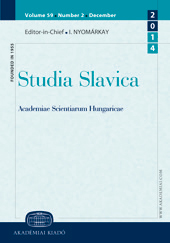
This paper analyzes G. Vinokur’s scientific heritage. The main focus is on the development of his ideas in the field of linguistic construction: from the first attempts at “linguistic technology” speech and the reform of traditional approaches to literature to the establishment of philology as a science. The scientist significantly contributed to sociolinguistics and the ecology of language, style and poetic linguistics, philological criticism and textology. His innovation is remarkable in the study and interpretation of the history and the theory of verbal culture.
More...
The traditions and stereotypes of perception and imagination of different dishes belonging to different national Slavonic cuisines could be considered as a special cultural and linguistic formation, a special layer. The article presents some of the stereotypes of “national menus” and their reflections in some Slavonic languages, including the phraseological level, especially in the culture of Ukrainians, Serbs, and Croats. Culinary and “cooking” metaphors often become the basis for creating expressivity.
More...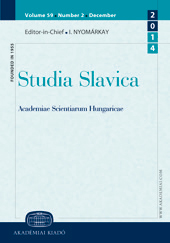
The paper deals with some food names in Russian (апельсин, ананас) within the framework of linguoculturological approach. The aim of this study is to analyze the main tendencies prevailing in the semantic adaptation of these loanwords that entered the Russian language in the 18th century. The first part is devoted to the conditions of appearance of these words in Russian culture and their semantic characteristics. The second part contains the description of semantic shifts that occur during the formation of cultural connotations of orange and pineapple. The author also demonstrates the manner in which semantic shifts can be used to describe a huge amount of cultural knowledge or cultural information. Proceeding from the notion of “cultural memory”, I set out to show that the phraseological meaning is a complex structure including semantic information and its conceptual basis. In my study, I would like to demonstrate what processes go on during its actualization in idiomaticity. The analysis is conducted on the basis of data found in the Russian National Corpus.
More...
The paper presents the results of a study of metaphorical vocabulary with the meaning of assessment of social change. The analysis involves common Russian vocabulary as well as the material of Russian dialects. Previously unpublished expeditionary records of dialect speech are introduced into academic discussion. Special attention is paid to the onomasiological analysis of linguistic facts. Four groups of motives are revealed: the motives of destruction (loosening, turning inside out, and death); spatially dynamic motives (moving away and disappearance); the motives of qualitative changes (the loss of one’s own properties and status, the acquisition of similarity with representatives of a foreign nation, the acquisition of worse properties, cooling down); and the motives of confusion (mixing of different cultures and disorientation). It is shown that the bearers of traditional folk culture tend to evaluate the changes of any kind as undesirable. A disapproving assessment of social change is due to the orientation of traditional culture toward strict adherence to customs.
More...
This paper examines the term ā-rè recorded in mediaeval Chinese historical sources as the title of the ruler of the Yenisei Kirghiz state. The author aims to discover which Old Turkic title this Chinese phonetic transcription corresponds to. By reconstructing the sounds in ā-rè according to Middle Chinese the author argues that the most likely pronunciation of the term was änäl, which he suggests is a phonetic variant of the Old Turkic title inäl. The author also argues that this was a temporary title of the ruler of the Yenisei Kirghiz during their vassalage under the Uyghurs.
More...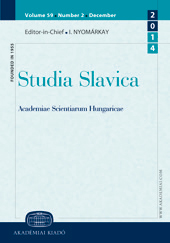
The present paper is devoted to the first Russian manuscript lexicons, which were commonly used in Moscovy during the 16th and 17th centuries. The author discusses the origin of foreign words, literary sources, and principles of the organization of dictionary entries in synchrony and diachrony.
More...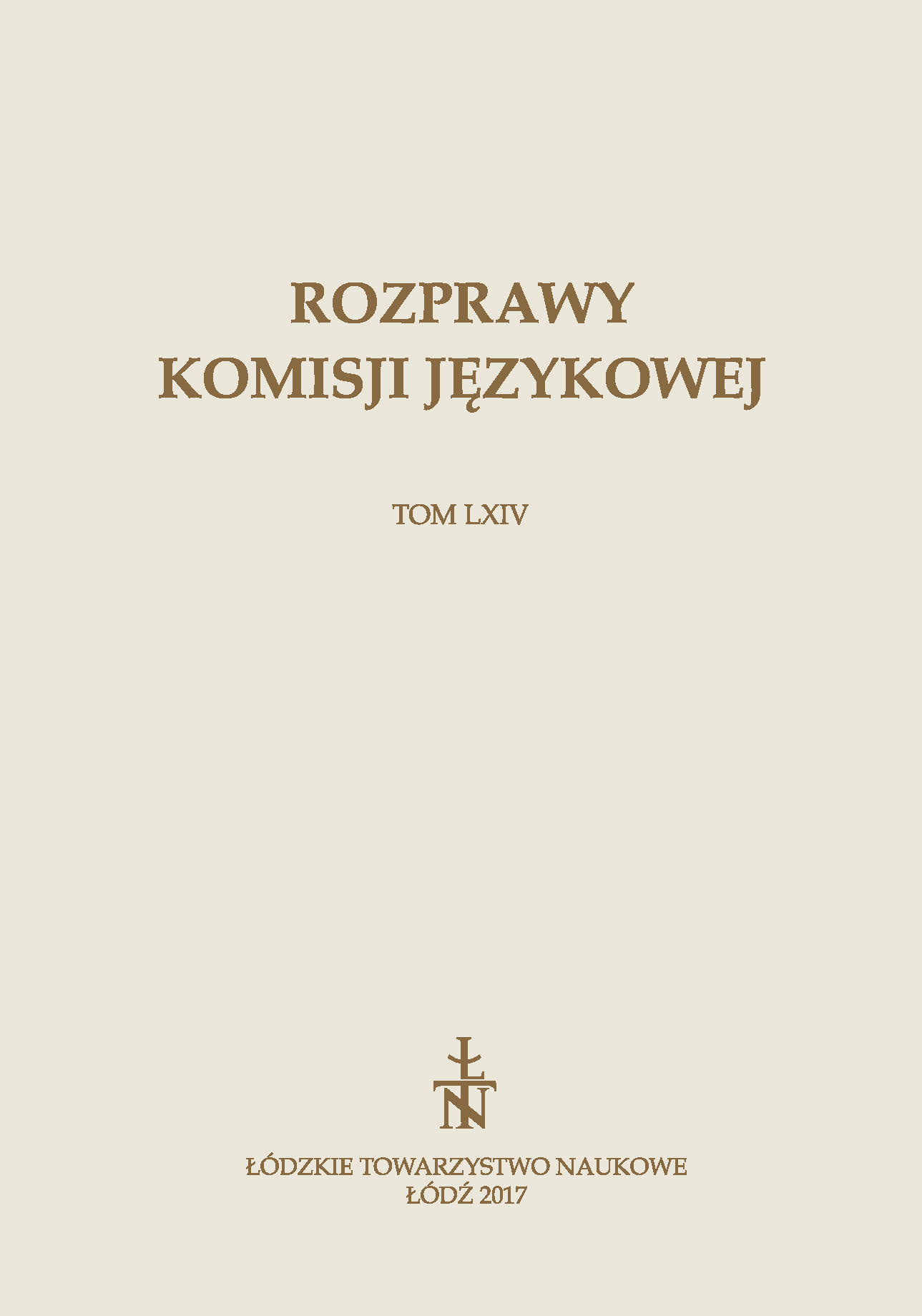
The paper shows the social status of dialects in the eighteenth-century Polish society. The first part of article contains theoretical attentions: findings of researchers and the opinions of witnesses era.It turns out that social scope of dialects was wider and not limited only to the peasants. The second part is an analysis of the names of whippletree. I used material from stock lists of the nobility from the second half of the eighteenth century from Wielkopolska, showing the presence of distinctive and regional vocabulary
More...
The aim of this article is to introduce a typology of Slavic immigrant dialects spoken in the Russian Federation. The paper deals with two Polish and three Czech varieties located in Siberia,in the case of the Czech ones also at the Black Sea coast of the Northern Caucasus and, partly,with West Ukrainian patois of Siberian Hollanders. The author outlines the current state of their research and analyzes the most eloquent examples of the phonological and grammatical resemblances between them which appeared mainly due to the fact that their original dialectal systems have been similarly influenced by their language surroundings, first of all by Russian. In particular attention is drawn to the problem of penetration of Russian palatalized consonants to phonetic or even phonological systems of those dialects. In morphology, it is shown that the functional sphere of some grammatical categories and forms has changed in the examined dialects not only under influence from Russian, but sometimes also as a result of their independent development in an insular situation.
More...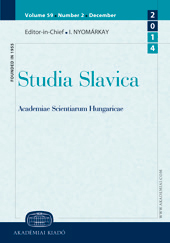
The present paper discusses the Russian lexemes горлопан ‘shouter, bawler’ and крыса ‘rat’, which are problematic from the point of view of etymology. The word горлопан can be explained as a compound, connected by grade haplology to Russian dialectal лопать ‘to shout’ and горло ‘throat’: горлопан = горло-лоп-ан > горлопан (because of expressivity). The Russian word крыса is seen as an expressive doublet to Slavic gryz-. The paper is based on historical and lexicological material, and uses dialectal examples that ensure the reliability of conclusions. The author pays particular attention to the semantic, phonetic, and derivational aspects of the etymology of the word.
More...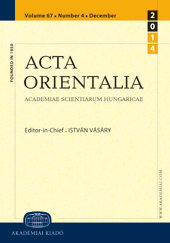
In the present paper I aimed to identify and separate the Kipchak (Northwestern Turkic) elements in the 13th – 14th-century Khwarezmian Turkic literary language, primarily drawing on the linguistic material of Gulistān bi’l-Turkī and Nahǰu’l-Farādīs. By comparing the grammars of several Khwarezmian Turkic writings and analyzing the complete vocabulary of the above two works, the relationship between Khwarezmian Turkic and the Kipchak languages becomes more transparent than hitherto thought of. The results may contribute to better understanding the heterogeneous views concerning Khwarezmian Turkic that appeared during the last one hundred years.
More...
Review of: 1. András Róna-Tas and Árpád Berta “West Old Turkic: Turkic loanwords in Hungarian (Turcologica 84).”; 2 volumes. Wiesbaden: Otto Harrassowitz, 2011. pp 1494. by: Klára Agyagási 2. Sándor Klára “Nyelvrokonság és hunhagyomány. Rénszarvas vagy csodaszarvas? Nyelvtörténet és művelődéstörténet [Linguistic affinity and the Hun tradition. Reindeer or miracle stag? Historical linguistics and cultural history].”; Budapest: TypoTEX, 2011. pp 468. by: István Vásáry
More...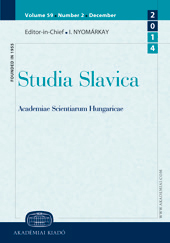
The Croatian Faust Vrančić published a five-language dictionary (Latin–Italian– German–Croatian–Hungarian) in the year 1595. This study examines to what extent the author knew these languages, apart from Latin. Not only does it scrutinise the knowledge of words of Vrančić but it also restores his awareness of the rules of the different languages, relying us several linguistic data. Vrančić must have had an excellent and active command of all the four languages, as the study finds it. The only difference in his awareness of languages can merely be pointed out in his vocabulary, concerning each. He knew the Hungarian language best and the Croatian language least. It can also be pointed out that the author was very resourceful in the field of lexicography
More...
It is commonly held among scholars that Aśoka’s Minor Rock Edicts were the king’s first attempts at engraving his messages on stone, and as such, they represent the earliest evidence for writing in India. While this may be true, it has not been duly emphasised that the text of the Minor Rock Edicts, in several versions as we have it, shows considerable traces of influence by the Major Rock Edicts and Pillar Edicts. Particular instances for such an influence in the text are the intrusion of the key term dhaṃma or the use of a general formulaic language characteristic of the later edicts. In our discussion, we wish to bring out some of these “Major” trends in the Minor Rock Edicts, making proposals for new interpretations and reading in Minor Rock Edicts I and II. On a similar basis, we will propose placing the Greco-Aramaic edict from Kandahar in the context of the Minor Rock Edicts, and try to account for the elements which may be derived from the Major Rock Edicts by the same scribal procedure as can be supposed to have been at work in formulating the text of the Minor Rock Edicts.
More...
Sanskrit pāmara and its Prakrit and Modern Indo-Aryan equivalents have a broad semantic field. The meaning of the word ranges from a very negative connotation “a low man”, “an outcast”, “a fool” to a positive term denoting a peasant who is a member of a rural community with full powers. The present paper explores the various shades of meaning of the word and their possible social background. The term first appeared in early mediaeval times and has remained productive in the various Modern Indo-Aryan languages spoken in India. The negative connotations of the word are typical of traditional Sanskrit lexicons, while the positive ones were used by poets and playwrights.
More...
In Mongolic, the words belge and mengge have practically the same meaning, cf. LM belge ‘sign mark, token, symptom, symbol; prognostic, omen’ and LM mengge ‘birthmark, mole; sign’. This paper aims to answer the question of whether these two words are etymologically related with each other or not, and also attempts to shed light on a question put forward by Gerhard Doerfer. In two of his works Doerfer (1992; 1993) suggested that there might be loanwords in Early Turkic taken from different Mongolic languages, but this idea has gone practically unnoticed in the Altaistic literature.
More...
In the present article, a remarkable phenomenon is brought to the attention of those interested in early Chinese translations of Buddhist texts: false friends in the Fanfanyu (T54n2130). Baochang’s Sanskrit–Chinese lexicon that was compiled as early as 517 AD reveals some curious examples of faux amis. In the present contribution, this case will be illustrated with references from the Shanjian lü piposha (T24n1462), a 5th century Chinese translation of the Samantapāsādikā, Buddhaghosa’s commentary on the Pāli Vinaya. The fact that Baochang did not realise that this text was not translated from Sanskrit, inadvertently gave rise to some interesting jeux de mots.
More...